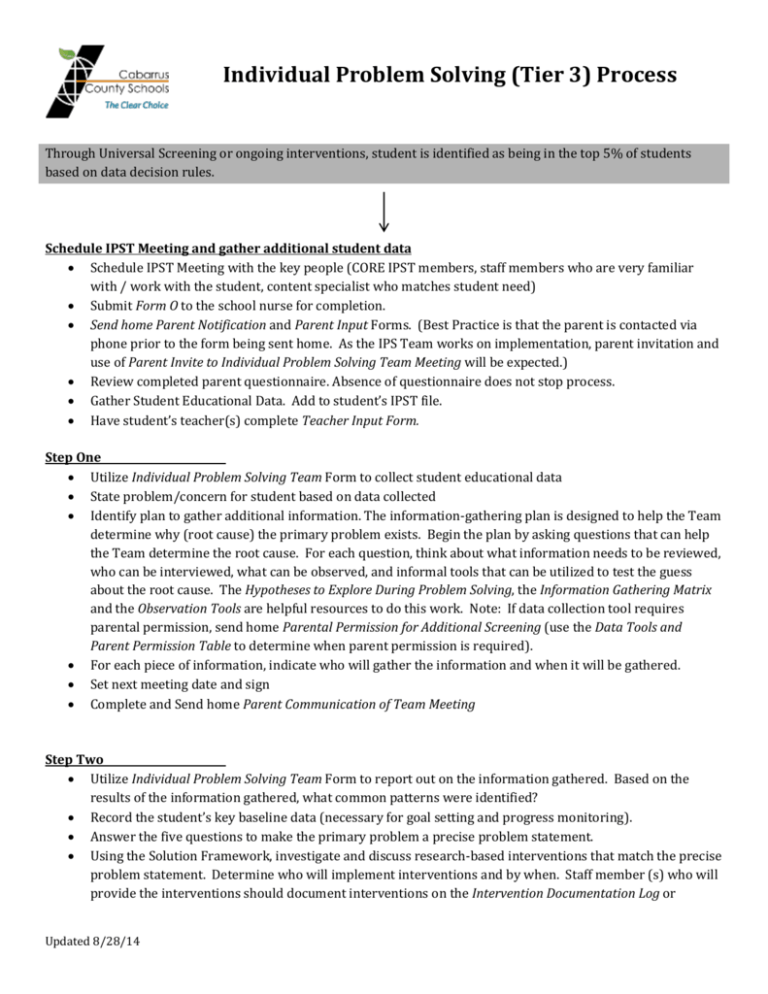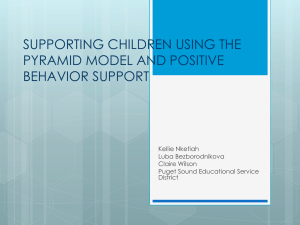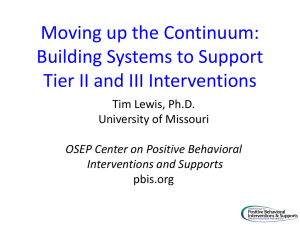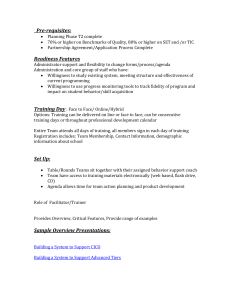Individual Problem Solving Process
advertisement

Individual Problem Solving (Tier 3) Process Through Universal Screening or ongoing interventions, student is identified as being in the top 5% of students based on data decision rules. Schedule IPST Meeting and gather additional student data Schedule IPST Meeting with the key people (CORE IPST members, staff members who are very familiar with / work with the student, content specialist who matches student need) Submit Form O to the school nurse for completion. Send home Parent Notification and Parent Input Forms. (Best Practice is that the parent is contacted via phone prior to the form being sent home. As the IPS Team works on implementation, parent invitation and use of Parent Invite to Individual Problem Solving Team Meeting will be expected.) Review completed parent questionnaire. Absence of questionnaire does not stop process. Gather Student Educational Data. Add to student’s IPST file. Have student’s teacher(s) complete Teacher Input Form. Step One Utilize Individual Problem Solving Team Form to collect student educational data State problem/concern for student based on data collected Identify plan to gather additional information. The information-gathering plan is designed to help the Team determine why (root cause) the primary problem exists. Begin the plan by asking questions that can help the Team determine the root cause. For each question, think about what information needs to be reviewed, who can be interviewed, what can be observed, and informal tools that can be utilized to test the guess about the root cause. The Hypotheses to Explore During Problem Solving, the Information Gathering Matrix and the Observation Tools are helpful resources to do this work. Note: If data collection tool requires parental permission, send home Parental Permission for Additional Screening (use the Data Tools and Parent Permission Table to determine when parent permission is required). For each piece of information, indicate who will gather the information and when it will be gathered. Set next meeting date and sign Complete and Send home Parent Communication of Team Meeting Step Two Utilize Individual Problem Solving Team Form to report out on the information gathered. Based on the results of the information gathered, what common patterns were identified? Record the student’s key baseline data (necessary for goal setting and progress monitoring). Answer the five questions to make the primary problem a precise problem statement. Using the Solution Framework, investigate and discuss research-based interventions that match the precise problem statement. Determine who will implement interventions and by when. Staff member (s) who will provide the interventions should document interventions on the Intervention Documentation Log or Updated 8/28/14 Individual Problem Solving (Tier 3) Process another easily accessible location that includes intervention name and description (i.e., group size, materials, how often and how long). Create a short-term (by next meeting) and long-term goal (grade level). Think about typical rates of improvement to create goals that are SMART: specific, measurable, attainable, relevant, and time-bound. Determine the plan for monitoring fidelity of implementation. Determine how it will be determined that the solution was effective (i.g., a progress monitoring plan). Set next meeting date and sign. If parent did not attend, complete and send home Parent Communication of Team Meeting. Step Three Review plan for monitoring fidelity. Indicate if the solution was: not started, partially implemented, implemented but not with fidelity, or stopped. Provide an explanation for why the Team checked the box (refer to Decision Making Tree below). Review progress-monitoring data. Determine if the data indicates student rate is: worse, no change, improved but not to the goal, or improved and met the goal. Provide an explanation for why the Team checked the box (refer to Decision Making Tree below). Complete the previous two bullets for each solution i.e., did we put the solution in place with fidelity—how do we know? Did the solution have the effectiveness we expected to see—does progress monitoring data indicate that the student is growing at a rate that will allow him/her to meet short and long-term SMART goals? (refer to Decision Making Tree below) Set next meeting date and sign If parent did not attend, complete and send home Parent Communication of Team Meeting Updated 8/28/14 Individual Problem Solving (Tier 3) Process Review Intervention Documentation. Were interventions provided with fidelity? Not started, Partial Implementation, Stopped Implemented with fidelity Discuss why the intervention was not started, partially implemented, or stopped. Update action plan (who, what, by when) to get solution in place. Sign. Set up follow-up date. Compare student’s rate of improvement to goal. Worse Student performance has not improved. Yes No. Resume: Identify Problem with Precision. Was SMART goal (short and long term) SMART? Yes Review DORA Fidelity Check. Begin second cycle. If second cycle does not result in improved student performance, then consider a more in-depth evaluation for special education eligibility. Updated 8/28/14 Improved and goal met If student continues to progress at current rate, will long-term goal be met? Team chooses: 1. Increase goal 2. Identify a new problem; begin with new problem at Step 1. 3. Discontinue Tier 3; Add to Data Team with progress monitoring Yes. Continue plan, set follow up date, sign. No. Resume: Identify Goal for Change. Was solution aligned to precise problem, research-based and implemented with fidelity? Yes Improved but not to goal No change Begin with precise problem. Are all components of precise problem accurate? No. Resume: Identify Solution, Implement with fidelity. Student performance has improved. No. Check timeline (was this a SMART Goal), review likepeer data (are peers with similar support performing similar to student), adjust solution. Set followup date. Sign. Key for Decision Making Tree Team questions and considerations Yes. Go to next step. No. Follow step(s).











